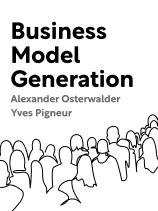

This article is an excerpt from the Shortform book guide to "Business Model Generation" by Alexander Osterwalder and Yves Pigneur. Shortform has the world's best summaries and analyses of books you should be reading.
Like this article? Sign up for a free trial here .
What is Osterwalder and Pigneur’s Business Model Generation about? What are the nine elements that make up a business model?
Business Model Generation by innovation experts Alexander Osterwalder and Yves Pigneur is a contemporary guide to systematic business innovation. The authors provide a template for brainstorming and visualizing the overarching elements that make up a successful, holistic business model. In addition, they provide techniques you can use to generate your own innovative business models, as well as strategies you can incorporate to regularly analyze and optimize your existing business models.
Below is a brief overview of the key points.
Business Model Generation: A Handbook for Visionaries, Game Changers, and Challengers
In Business Model Generation, Osterwalder and Pigneur outline the different ways you can combine nine different elements to create the most successful business model patterns. In addition, they provide techniques you can use to generate your own innovative business models, as well as strategies you can incorporate to regularly analyze and optimize your existing business models.
The Business Model Canvas
Osterwalder and Pigneur developed a flexible template, which they refer to as the “Business Model Canvas,” to help you understand and focus on the nine overarching elements that they believe make up any successful business model. The template offers a visual framework to describe, assess, update, or design business models. You can use it to analyze the strategies of your competitors, to evaluate or to create new strategies for your existing business, or to design an entirely new business.
(Shortform note: The Lean Canvas is a popular adaptation of the Business Model Canvas. Developed by Ash Maurya, the author of Running Lean, it’s designed specifically for action-orientated start-up companies that rely on continuous experimentation to develop their products and services. Consequently, it places more emphasis on defining customer problems and identifying competitive solutions.)
The 9 Elements of the Business Model Canvas
Osterwalder and Pigneur encourage you to consider each of the nine elements as interdependent components that impact the effectiveness of the other elements. In other words, changes to one element can impose constraints or amplify the effects of other elements. Therefore, as you work on your business models, consider how you can leverage all of your elements to work together.
Element 1: Define Your Customer Groups
Define the different groups of customers your business intends to target—Osterwalder and Pigneur refer to this element as “Customer Segments.” You may serve one group of customers or several groups of customers depending on the needs you intend to fulfill.
| The Four Steps to the Epiphany by Steve Blank emphasizes the importance of identifying and validating your customer groups before you develop your business model. The book includes a four-step customer development process to help businesses effectively define and target customer groups. |
Element 2: Define Your Touchpoints
Define your touchpoints, how you’ll communicate with your customers and deliver your products and services—Osterwalder and Pigneur refer to this element as “Channels.” For your communication, sales, and distribution, you have the option of using your own touchpoints (assets under your direct control such as your website or your store), or partner-owned touchpoints (external touchpoints that result from cooperation with marketing agencies or distribution partners), or a mix of both. In addition, the authors also make a distinction between direct touchpoints (communication you control such as your blog), and indirect touchpoints (communication you can’t control such as user reviews).
Touchpoints and Interactions (Element 3) are closely linked—consider the level of interaction you want to have with your customers when defining your touchpoints.
| Businesses tend to assume that more touchpoints will lead to more customers, so they work hard to create multiple interaction points across the five stages. However, research indicates that too many touchpoints can reduce the quality of service that you deliver and damage customer experience. Customers care more about the quality of service you provide than what touchpoints you use—you’re more likely to create successful channels if you prioritize the development and integration of fewer touchpoints. |
Element 3: Define Your Interactions
Define the type of interactions you want to establish for each of your customer groups—Osterwalder and Pigneur refer to this element as “Customer Relationships.” The authors advise that you consider what your motivations are for communicating with your customers as your approach will differ depending on whether you intend to acquire new customers, retain existing customers, or upsell to existing customers.
| Brand relationship experts have identified 29 different types of interactions that customers expect from a business—they use relationship metaphors such as “one-night stand” or “marriage” to clearly define each interaction. These experts argue that businesses can’t understand or leverage customer relationships unless they collect and analyze the relationship signals their customers send. |
Element 4: Define Your Value Offer
Define how you intend to offer value to these customers—Osterwalder and Pigneur refer to this element as “Value Propositions.” Your value offer outlines the benefits you intend to provide in the form of products and services. The authors state that successful value offers align with the needs of your customers and differentiate themselves from existing solutions.
| Businesses often associate value creation with competition—they assume that they need to offer something that outperforms and displaces what’s currently on the market. However, Sesame Street, life coaching, and Viagra all prove that it’s possible to create innovative products and services without disrupting existing markets. Instead, the businesses behind these products and services bypass competition by focusing on creating demand in entirely new marketplaces. |
Element 5: Define Your Resources
Define what resources you need to create and deliver your products and services to your customer—Osterwalder and Pigneur refer to this element as “Key Resources.” According to the authors, you can own, lease, or acquire the resources you need. All resources fall into the following categories: material, monetary, intellectual, and human.
| This method often highlights the need to acquire more resources before you can move forward with your business model. However, some businesses approach this in reverse: They use their resource limitations to inspire product and service innovations. For example, Southwest Airlines used its resource constraints to reposition its offering and become one of the most profitable airlines in the industry. |
Element 6: Define Your Network
Define the alliances you need to form to optimize your business model and increase market share, acquire resources, or reduce risk—Osterwalder and Pigneur refer to this element as “Key Partnerships.” In other words, what alliances will provide you with a sustainable competitive advantage and help you to grow quickly?
| One innovation expert compares strategic alliance relationships to marriage—like marriage, many strategic alliances fail to live up to expectations. In other words, both suffer from a high failure rate. However, the expert argues that strategic alliances are more likely to succeed if businesses focus on creating strong foundations built on shared values and mutual benefits. |
Element 7: Define Your Critical Actions
Define the core actions you need to take to operate successfully and meet customer demands—Osterwalder and Pigneur refer to this element as “Key Activities.” The authors state that your actions will fall into the following categories: production (designing, manufacturing, and delivering products), troubleshooting (finding solutions to problems), and infrastructure management (managing interactions between multiple applications and parties).
| Osterwalder and Pigneur don’t provide practical advice here since different business models rely on different activities to operate successfully. Measure What Matters provides an effective goal-setting process that you can use to define the objectives and key results for each of your business model elements. For example, if your objective is to acquire X number of customers in each customer group, your key results could be growing platform visitors by 5% every month and increasing organic traffic by 10% every six weeks. |
Element 8: Define Your Profit Sources
Define how you intend to profit from the value you provide to your customers—Osterwalder and Pigneur refer to this element as “Revenue Streams.” The authors state that there are two types of income streams to consider: profits from single transactions and profits from ongoing payments such as subscriptions. You may have multiple income streams for each of your customer groups. Further, each of these income streams may involve different pricing mechanisms depending on whether you choose to set a fixed or variable price for your products and services.
| How should you determine the price for your products and services? Many businesses determine their prices using the cost-plus method—calculate the costs involved and add on a percentage (desired profit). However, experts argue that businesses need to consider how much value customers attach to their products and services before they determine their prices. |
Element 9: Define Your Expenses
Define the expenses of operating all of the elements you’ve defined in your business model—Osterwalder and Pigneur refer to this element as “Cost Structure.” Your expenses will vary depending on whether you choose to minimize costs and offer an inexpensive product or service, or if you choose to create premium-priced products and services. The authors state that your cost structures will include at least one of the following characteristics: fixed costs (salaries, rent), variable costs (costs that vary in proportion to the volume of goods or services produced), economies of scale (bulk purchase rates lessen cost per unit), and economies of scope (a single resource or activity supports multiple operations or services).
(Shortform note: All of your costs will also fall into the following categories: direct costs and indirect costs. Knowing the difference between these costs will help you to identify your overall business expenses.)
Business Model Formulas
Osterwalder and Pigneur argue that the nine elements can combine into distinct patterns to create specific outcomes. To illustrate this, they present patterns they claim are common across all successful business models—a single business model can include several of these patterns. Once you familiarize yourself with these patterns, you’ll understand how the combination of certain elements can create dramatically different results, and you’ll be better prepared to manipulate the elements to successfully position your business.
(Shortform note: The Business Model Navigator presents an alternative way to approach business model patterns—it offers 55 patterns that you can pick and choose from, manipulate and combine to suit your needs. This method may be more suitable for established businesses that seek to innovate existing business models.)
Formula 1: Unbundled
Unbundled businesses split up (“unbundle”) their operations into three distinct business categories to increase efficiency: product innovation, customer relationship management, and infrastructure management.
Some business experts argue that businesses that offer services in one or more of these distinct categories can’t operate efficiently unless they unbundle. Further, they advise that businesses should focus only on one of these categories as their core service, and outsource the rest to specialized companies. As long as more than one of these activities coexists on a single business model, each of the elements will include conflicting priorities that will create limitations or “tradeoffs” across the business.
Businesses Focused on Product Innovation:
- Focus: This business category aims to create the most innovative product or service on the market.
- Strategy: Businesses focused on innovation need to hire talented designers and develop efficient systems to commercialize ideas quickly.
- Resources: Successful product innovation requires investment in research, development, and talented employees.
Businesses Focused on Customer Relationship Management:
- Focus: This business category aims to nurture long-term relationships with customers.
- Strategy: Businesses focused on customer relationships need to look beyond the value of single transactions and focus on the lifetime value of their customers.
- Resources: In addition to tailoring products and services to satisfy customers in each customer group, businesses need to invest heavily in developing their touchpoints and customer interactions.
Businesses Focused on Infrastructure Management:
- Focus: This business category aims to operate as efficiently and as cost-effectively as possible.
- Strategy: Businesses focused on infrastructure management adopt strategies that minimize costs and optimize efficiency wherever possible.
- Resources: Reliable and cost-effective infrastructures depend on economies of scale and standardized processes to keep costs down.
| Osterwalder and Pigneur refer to the recommendation from management experts that companies should narrow their business focus on delivering superior value in line with one of three “value disciplines”: product leadership, customer intimacy, or operational excellence. These value disciplines complement the three business categories and support the argument to “unbundle” the services. Interestingly, companies that focus on the same value disciplines display similarities in the way that they operate, regardless of their industry. For example, the operating structures and workplace cultures of Federal Express and Walmart are almost identical because they both pursue operational excellence. |
Formula 2: Long Tail
Long Tail businesses focus on creating a wide variety of diverse niche products and services for interested buyers—individually, each of these products sells very little, but the combined sales of all of the products generate high revenues. These models require cost-effective ways to manage large inventories, reach potential buyers, and facilitate transactions. Osterwalder and Pigneur suggest the following layout for Long Tail business models:
- Customer Groups: Focus on multiple niche customer groups as well as multiple niche suppliers—both groups are interdependent.
- Value Offer: Value comes from offering a wide range of niche products alongside a few mainstream products. Additional value comes from providing content production tools for users to co-create products.
- Profit Sources: Profit sources will come from combined sales across the platform, as well as paid advertisements.
- Critical Actions: Develop, manage, and promote the platform to acquire niche content suppliers and customers.
- Network: Focus on developing partnerships with both professional and amateur niche content providers. In addition, focus on partnerships that will make the platform more functional or attractive to both suppliers and customers.
| Book Publishing: From Mainstream to Long Tail The Long Tail formula seems to fly in the face of the common advice to focus on a single niche product or service (in other words, to prioritize one thing and do that thing exceptionally well). Further, expanding your offerings according to the Long Tail formula could be the key to disrupting the market and winning big. Changes in the publishing industry are a great example of this. Traditionally, publishers had to print and distribute books to bookstores before they could sell them. This incurred heavy printing, inventory, and distribution costs. Publishing houses were responsible for managing the editorial, marketing, production, and distribution costs for each title they published. In addition, brick and mortar bookstores had limited shelf space to stock books. Therefore, the majority of bookstores stocked only the bestselling titles. Amazon’s long tail model disrupted this model in two ways. First, it made more books available to customers through Amazon Marketplace. Second, it allowed authors to self-publish their own books through Amazon Kindle Direct Publishing (KDP). Amazon Marketplace isn’t restricted by shelf space or inventory costs—print-on-demand facilities allow them to store books as electronic files instead of hard copies. Amazon creates demand by displaying customer reviews and facilitates the purchase of these books. More than half of Amazon’s book sales come from books that aren’t sold in traditional bookstores—Amazon created a new market based on books customers actually want. Additionally, Amazon KDP doesn’t have to cover the editorial or marketing costs for self-published books. Millions of authors use Amazon KDP to self-publish books, and while they don’t sell every one of these books, the aggregate sales of all of the books allow Amazon KDP to thrive. |
Formula 3: Multi-Sided Platforms
Multi-Sided Platforms provide an infrastructure to enable direct interaction between two or more different but interdependent groups of customers. This pattern is most obvious in a marketplace such as Etsy—this business facilitates exchanges between buyers and sellers, and it requires participation from both parties to offer value and operate successfully. In other words, if sellers stopped listing items on Etsy, customers would see no value in visiting the site. If customers stopped shopping on Etsy, sellers would see no value in listing their products. The more active users that a platform can attract, the more value it can offer to both parties.
Osterwalder and Pigneur suggest the following layout for Multi-Sided Platform business models:
Customer Groups: Focus on a minimum of two interdependent customer groups.
Value Offer: Value comes from the platform—it facilitates efficient and cost-effective interactions between the customer groups.
Profit Sources: Each group produces a different revenue stream depending on the fees they pay to use the platform (for marketplaces, sellers usually pay subscription fees while buyers have free access).
Critical Actions: Develop, maintain, and promote the platform to ensure it meets the needs of individual customer groups.
Network: Focus on developing partnerships that will make the platform more functional or attractive to all customer groups.
| The Negative Impact of Network Effects on Sellers As discussed, a multi-sided platform increases in value the more people use it. However, the more saturated these marketplaces become, the more difficult it is for sellers to stand out and attract the attention of buyers. Over-saturation of the platform creates a high risk of sellers moving to platforms with lower fees or access to different customer groups. Consequently, multi-sided platforms have to compete fiercely on both price and quality to keep their sellers from switching to competitor platforms. |
Formula 4: Free
The Free business model pattern ensures that at least one customer group always receives value for free. While different patterns make the model financially viable, Free users are always financed by another part of the business model or by another customer segment. Osterwalder and Pigneur categorize Free models into three groups, based on where their revenue comes from: advertising, premium services, and continuing purchases.
Advertising
Multi-Sided Platforms encourage advertisers to subsidize free users. For example, the revenue that Google receives from advertisers enables Google users to make unlimited searches for free. The more free users, the more advertisers are willing to pay to access these users. Osterwalder and Pigneur suggest the following priorities for Free business models subsidized by advertising revenues:
Customer Groups: Focus on large customer groups to entice advertisers.
Value Offer: Value comes from providing a free product or service to customers. The resulting customer base will create value for advertisers.
Profit Sources: Profit comes from advertisers using the platform.
Critical Actions: Develop and maintain the platform to entice both customers and advertisers.
Network: Focus on developing partnerships that will make the platform more functional or attractive to all customer groups.
| Facebook’s Advertising Revenue Facebook has two primary groups of customers: Users, who they provide value for in the form of free communication, and advertisers, who they rely upon for revenue. Facebook collects and analyzes data to categorize each of its users, then auctions off advertising space within users’ feeds and stories based on these categorizations. Facebook has faced many accusations regarding the way it manages the security and privacy of its users. However, Facebook doesn’t sell personal data to advertisers—just advertising space based on user demographics. Still, the increasing scrutiny of the government and public demonstrates that applications of this Free model may need to change in the future. |
Premium Services
Premium Service models—Osterwalder and Pigneur refer to these as “Freemium models”—give customers the option to use the basic service for free or to pay for premium or additional services. The revenue from paying customers supports the costs incurred by the free users. For example, Evernote offers three plans to users: free, personal, and professional, and users can choose to upgrade and pay if the free service doesn’t meet their needs. Osterwalder and Pigneur suggest the following layout for this type of business model:
- Customer Groups: Focus on creating a large group of free users. Eventually, convert a portion of this group into paying users.
- Value Offer: Value comes from providing a free basic service to a large customer group, as well as offering a premium service to a smaller customer group.
- Profit Sources: Profit will come from customers paying for premium services. Calculate the conversion rate from free users to premium users to determine profit.
- Critical Actions: Develop, maintain, and promote the platform to ensure it meets the needs of both free and paying users.
- Network: Focus on developing partnerships that will make the platform more functional or attractive to both free and paying users.
| The Difference Between Freemium and Free Trial Both customer acquisition methods offer free services to customers. However, Freemium models provide “free value forever,” and this is more attractive to users than “free value for a limited time.” Consequently, businesses using Freemium models are more likely to grow their customer base at a much faster rate than businesses using Free Trials. However, the problem with Freemium models is that they create no sense of urgency for users to upgrade—converting free users to paying users can take months or years, if ever. Meanwhile, businesses have to pay to maintain and develop the services it offers to these users. |
Continuing Purchases
Continuing Purchases models—Osterwalder and Pigneur refer to these as “Bait and Hook” models—are characterized by cheap or free products that provide customers with instant gratification but create demand for future products and services. Although businesses initially lose money, they can easily cover the costs and make a profit from the recurring income they receive from these transactions. For example, coffee machines that require specific capsules to function can sell at a loss since customers will inevitably pay for the capsules so that they can use the machine. Osterwalder and Pigneur suggest the following layout for this type of business model:
- Customer Groups: Focus on large customer groups.
- Value Offer: Value comes from attracting customers with an inexpensive or free offer, which will lead to a necessary follow-up product or service.
- Profit Sources: Profit will come from multiple purchases of the follow-up product or service.
- Critical Actions: Focus on the production and delivery of follow-up products & services.
- Network: Focus on developing partnerships that will make the production and delivery of follow-up products and services more efficient.
| Reversing the Model Business models focused on continuing purchases generally offer the premium product (for example, coffee machine or printer) at a low cost and its complementary product (coffee capsules, printer ink) at a high price. However, this gamble doesn’t always pay off—savvy buyers may calculate the ongoing expenses of owning such products and choose not to take the bait. The result is that businesses may end up making an overall loss from this model. Many businesses have found the reverse of this model to be even more successful: They offer the premium product at a high price and the complementary product at a low price. |
Formula 5: Open
Businesses with Open business models create opportunities for innovation and efficiency by collaborating or co-creating with external partners. For example, NASA collaborated with TopCoder, Harvard Business School, and London Business School, to build an algorithm to assist manned missions. Osterwalder and Pigneur claim that there are two ways to create value through collaboration—businesses can either receive and integrate external resources to strengthen their own business models, or they can leverage their internal resources by supplying them for a fee.
For example, a business might supply external partners with intellectual property and profit from selling off any other resources that aren’t required internally. A business might receive resources from external partners, such as patents or research results, that contribute to the creation of innovative products and services.
(Shortform note: In addition to identifying physical and intellectual resources, businesses can also create value by leveraging their brand equity. For example, Xiaomi grew to become the world’s leading consumer internet-of-things company by forming alliances with partner firms. Xiaomi offered these partner firms significant value in the form of physical and intellectual resources such as research, development, and manufacturing resources, as well as brand capital—the firms benefited from access to Xiaomi’s millions of existing loyal customers without having to go through the long process of building a customer base and developing trust.)
Formula 6: Nonprofits and Beyond-Profits
Although nonprofit and social causes organizations do not seek to make profits in the conventional sense, they still need to have a business model to plan how they will meet their objectives and cover their expenses. Osterwalder and Pigneur distinguish between two different business model patterns defined by how these organizations receive revenue: donor-supported organizations and organizations that balance profit with social and environmental impact.
Donor-Supported Organizations
When third-party donors fund the organization’s mission, the business model has to place emphasis not only on how to fulfill the mission but how to appeal to third-party donors so that they support the mission. Therefore, the organization has to manage third-party donors in the same way that conventional profitable businesses manage their customers. Consequently, the development and management of these relationships form a large part of the organization’s activities.
(Shortform note: Aligning both donors and beneficiaries into one business model is difficult to balance. Donor-Supported Organizations need to focus on fulfilling their mission, but they also need to fully consider how they create value for their donors. In other words, donors are more likely to contribute if organizations can provide proof of specific and measurable improvements made possible by their donations.)
Organizations That Balance Profit With Social and Environmental Impact
When the organization has to generate its own revenue to fulfill its mission, Osterwalder and Pigneur suggest that it should balance its need to make profits with its need to make a positive social and environmental impact. To evaluate this impact, the authors recommend extending the business model to include two additional elements: social and environmental costs of this business model, and social and environmental benefits of this business model.
(Shortform note: Many experts believe that all businesses should be held accountable for their environmental, social, and governance (ESG) impact, not just businesses that focus on social causes. However, companies haven’t quite figured out how to measure their ESG impact.)
Innovation and Strategy Techniques
Osterwalder and Pigneur provide a number of techniques you can use to generate innovative ideas to adapt or create your own business models. Further, there are a number of strategies you can incorporate to help you regularly analyze and optimize the effectiveness of your business models.
1. Generate innovative ideas: Osterwalder and Pigneur argue that you first need to generate and evaluate a large number of ideas before you can come up with viable options to create an innovative business model. The authors suggest you use one of the following objectives to trigger innovative ideas: serve unmet market needs, create new products or services, disrupt an existing market, or create a new market.
(Shortform note: The authors don’t mention that there are other significant opportunities to spark innovation. For example, shifts in the economic environment (growth or turmoil) can create new customer preferences and spending habits that trigger business innovation.)
2. Empathize with your customers: Osterwalder and Pigneur argue that if you find out what your customers want and figure out ways to help them before you design your products and services, you’re more likely to discover new opportunities and create a strong foundation for your business model.
(Shortform note: Specifically look for problems and inconveniences that your customers face both throughout their experience with your business and their experience with your products and services.)
3. Create visual representations: Osterwalder and Pigneur argue that visual representations of your business model allow you to better understand how each of your elements connects and interrelates.
(Shortform note: The Back of the Napkin argues that drawings can solve any problem, even if we’re convinced that we have no aptitude for it.)
4. Build detailed scenarios: Osterwalder and Pigneur suggest that you regularly create scenarios around possible future environments and the impact they will have on the way you operate. The authors recommend that you base your scenarios on the following four areas of your business environment: market, industry, key trends, and macroeconomics.
(Shortform note: Many experts argue that businesses need to consider how to evaluate and manage unanticipated external risks in advance, and develop appropriate risk management strategies to lessen their impact. For the purposes of this technique, you’ll find it beneficial if you focus on early indicators of change in your environment before you build your future scenarios.)
5. Create a story to communicate your business model: Osterwalder and Pigneur claim that creating a story centered around the value that your business model offers, from the perspective of either an employee or customer, will enable you to engage your listeners and effectively communicate your business model.
(Shortform note: You’re more likely to engage and resonate with your listeners if you recognize that each audience you address has different priorities. For example, your team cares about how your business model will affect their jobs, whereas your investors care about how they’ll profit from your business model.)
6. Prototype multiple versions of your business model: Osterwalder and Pigneur argue that prototypes of your business model will allow you to better understand the structure and combined effects of your elements. With this understanding, you can create multiple prototypes to explore and test various possibilities and strategic directions.
(Shortform note: The sooner you test your business model, the sooner you’ll know if your business model is worth investing in. There are a number of tools that you can use to test the viability of your business model. For example, you can use targeted advertising to measure consumer interest, or use your email database to test your value offer on existing customers.)
7. Use a SWOT analysis to evaluate your business model: Osterwalder and Pigneur suggest that you regularly use the Strengths, Weaknesses, Opportunities, and Threats (SWOT) analysis to evaluate the effectiveness of each of your individual elements, as well as your overall business model.
(Shortform note: There are various alternatives to the SWOT analysis that the authors don’t mention. For example, NOISE would be useful when you’re actively looking for solutions to solve problems within your organization, whereas Porter’s Five Forces Model offers an effective way to analyze your competition.)
8. Use Blue Ocean Framework to evaluate your business model: Osterwalder and Pigneur argue that using the “Four Actions Framework” to analyze the impact of each of your elements will put you in a position to create demand for innovative products and services in unclaimed markets.
(Shortform note: Porter’s Five Forces argues that businesses need to continually assess their competition to remain relevant in the marketplace. Management experts suggest that a blend of both strategies can be effective—use the “Four Actions Framework” to create your new market and then use Porter’s Five Forces to defend against your eventual competitors.)
9. Align your organization and resources: In addition to assessing your technology and resource requirements, the authors suggest that you use Jay Galbraith’s Star Model to assess whether you need to restructure or adapt your business operations to successfully implement your business model:
(Shortform note: One criticism of this approach is that it doesn’t offer any flexibility for you to adapt your business model. An alternative approach is to use your company values as a starting point—aligning your business model with your company’s values (instead of vice versa) will allow you the flexibility to innovate without having to evaluate your organizational structure.)

———End of Preview———
Like what you just read? Read the rest of the world's best book summary and analysis of Alexander Osterwalder and Yves Pigneur's "Business Model Generation" at Shortform .
Here's what you'll find in our full Business Model Generation summary :
- The nine elements that make up any successful business model
- Different ways you can combine these elements to create business model patterns
- Techniques you can use to generate innovative ideas






